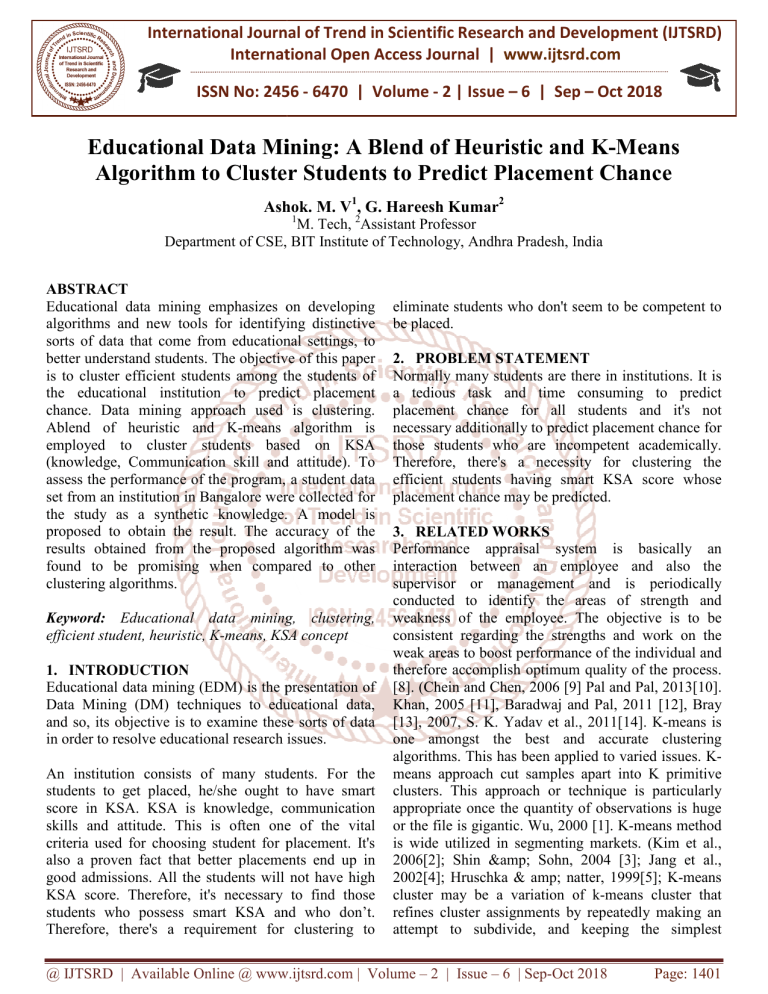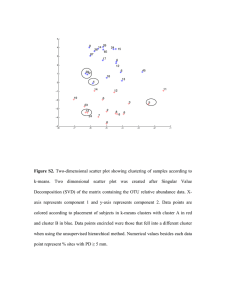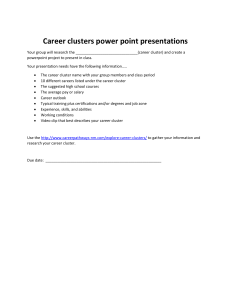
International Journal of Trend in Scientific Research and Development (IJTSRD)
International Open Access Journal | www.ijtsrd.com
ISSN No: 2456 - 6470 | Volume - 2 | Issue – 6 | Sep – Oct 2018
Educational
ucational Data Mining: A Blend of Heuristic and K-Means
K
Algorithm to Cluster Students tto
o Predict Placement Chance
Ashok. M. V1, G. Hareesh Kumar2
1
M. Tech, 2Assistant Professor
Department off CSE, BIT Institute of Technology, Andhra Pradesh, India
ABSTRACT
Educational data mining emphasizes on developing
algorithms and new tools for identifying distinctive
sorts of data that come from educational settings, to
better understand students. The objective of this paper
is to cluster efficient students among
ong the students of
the educational institution to predict placement
chance. Data mining approach used is clustering.
Ablend of heuristic and K-means
means algorithm is
employed to cluster students based on KSA
(knowledge, Communication skill and attitude). To
assess
ssess the performance of the program, a student data
set from an institution in Bangalore were collected for
the study as a synthetic knowledge. A model is
proposed to obtain the result. The accuracy of the
results obtained from the proposed algorithm was
found to be promising when compared to other
clustering algorithms.
Keyword: Educational data mining, clustering,
efficient student, heuristic, K-means,
means, KSA concept
1. INTRODUCTION
Educational data mining (EDM) is the presentation of
Data Mining (DM) techniques
ques to educational data,
and so, its objective is to examine these sorts of data
in order to resolve educational research issues.
An institution consists of many students. For the
students to get placed, he/she ought to have smart
score in KSA. KSA is knowledge,
owledge, communication
skills and attitude. This is often one of the vital
criteria used for choosing student for placement. It's
also a proven fact that better placements end up in
good admissions. All the students will not have high
KSA score. Therefore, it's necessary to find those
students who possess smart KSA and who don’t.
Therefore, there's a requirement for clustering to
eliminate students who don't seem to be competent to
be placed.
2. PROBLEM STATEMENT
Normally many students are there in institutions.
institut
It is
a tedious task and time consuming to predict
placement chance for all students and it's not
necessary additionally to predict placement chance for
those students who are incompetent academically.
Therefore, there's a necessity for clustering the
th
efficient students having smart KSA score whose
placement chance may be predicted.
3. RELATED WORKS
Performance appraisal system is basically an
interaction between an employee and also the
supervisor or management and is periodically
conducted to identify the areas of strength and
weakness of the employee. The objective is to be
consistent regarding the strengths and work on the
weak areas to boost performance of the individual and
therefore accomplish optimum quality of the process.
[8]. (Chein and Chen, 2006 [9] Pal and Pal, 2013[10].
Khan, 2005 [11], Baradwaj and Pal, 2011 [12], Bray
[13], 2007, S. K. Yadav et al., 2011[14]. K-means
K
is
one amongst the best and accurate clustering
algorithms. This has been applied to varied issues. KK
means approach cut samples
mples apart into K primitive
clusters. This approach or technique is particularly
appropriate once the quantity of observations is huge
or the file is gigantic. Wu, 2000 [1]. K-means method
is wide utilized in segmenting markets. (Kim et al.,
2006[2]; Shin & Sohn, 2004 [3]; Jang et al.,
2002[4]; Hruschka & amp; natter, 1999[5]; K-means
K
cluster may be a variation of k-means
k
cluster that
refines cluster assignments by repeatedly making an
attempt to subdivide, and keeping the simplest
@ IJTSRD | Available Online @ www.ijtsrd.com | Volume – 2 | Issue – 6 | Sep-Oct
Oct 2018
Page: 1401
International Journal of Trend in Scientific Research and Development (IJTSRD) ISSN: 2456-6470
2456
ensuing splits, till some criterion is reached. Dan
pelleg, andrewMore, K-means:
means: Extended K
K-means
which is an effective Estimation of the quantity of
Clusters [6], Thomas aloe, Remi Servien, The K
K-Alter
algorithm: a parameter-free
free method to perform
unsupervised clustering [7].
4. METHODOLOGY
Fig 1: Proposed Methodology
Concept and research framework
The methodology along with its computational
processes for determining the efficient student, is
outlined below:
Step 1: Data collection.
The goal is to identify proficient students
st
within the
college under consideration viz., KK for the year
2017-18.The
18.The students hail from numerous courses.
The courses are MBA, MCA, BCA, B.Com, and
BBA.
Step 2: Data pre-processing
processing using normalization
In our study, the attribute ‘percent’ is measured
me
in (%)
and ‘skill’ using numbers starting from [1 to 10].
In our study percentage (%) prevails on skills.
Therefore, there's a necessity for standardization or
normalization.
Step 3: Proposed Clustering technique
This step clusters efficient students
student among all the
students of the institution using proposed clustering
algorithm.
Step 4: Evaluate the result
5. DATA DESCRIPTION
Variables
Table 1: Database Description
Description
Possible Values
Stu id
Id of the student
{Int}
Name
Name of the Student
{TEKT}
EKT}
Sub
Subject Name
{TEKT}
M1, M2, M3, M4… Marks scored in each subject
{1, 2, 3, 4, 5...100}
T in %
Total marks
{ 1% - 100% }
Skill
(Communication skills+Attitude) score out of 10 {1, 2, 3, 4, 5...10}
Min
Minimum Marks for passing a subject
32
Max
Maximum Marks for passing a subject
100
Stu_Id:– ID of the student. It can take any integer values.
Name: - Name of the student.
Sub: –
represents the name of the topic. It will take solely the values starting from A-Z.
A
M1, M2, M3..:–various subject marks scored by a student. It will take solely the numeric values from 0 to 100.
T: –
total marks scored by every student depicted within the form percentage i.e., 1% to 100%.
Skill: –
Communication and attitude score out of ten
Min: Minimum marks for passing
assing a subject
Max: - maximum marks for passing a subject
@ IJTSRD | Available Online @ www.ijtsrd.com | Volume – 2 | Issue – 6 | Sep-Oct
Oct 2018
Page: 1402
International Journal of Trend in Scientific Research and Development (IJTSRD) ISSN: 2456-6470
2456
6. EXPERIMENTAL EVALUATION
Step 1: Data collection
Table 2: Input Table
Stu id
1
2
3
4
….
Name
Vikas Guru Sayed Deepak …
Sub
Min MaK M1
M2
M3
M4
M5
100
20
98
45
92
32
…
Ca
32
100
23
98
69
83
Bi
…
32
100
24
97
67
74
Java
…
32
100
25
96
89
92
Se
…
32
100
26
95
88
88
Cf
…
100
28
90
56
81
32
…
Db
…
…
…
…
…
…
…
…
25
90
65
80
…
T in %
7
9
7
8
Skill
Fields or variables listed higher than Marks scored in selected subjects for the yea
yearr 2017-18
2017
is considered and
collected from an institution in city.
Step 2: Data Pre-processing:
Pre-processing
processing is done using Normalization.
Table 3: Pre-processed
processed table
Stu id 1
2
3
4
…
Sub M1 M2 M3 M4 M5
20 98 45 92 …
Ca
23 98 69 83 …
Bi
24 97 67 74 …
Java
25 96 89 92 …
Se
26 95 88 88 …
Cf
28 90 56 81 …
Db
…
..
… … …
…
T in
25 90 65 80 …
%
7
9
7
8
…
Skill
Steps of the proposed algorithm are explained below:
Step 1:
Clustering using proposed algorithm.
Step 1.1: Pre-processed table are going to be the
input.
Step 1.2: Cluster efficient students and determine
the precise number of clusters. K
K-value is
calculated using heuristic method by
incrementing the K-value
value in each step by
one and the results are shown below.
Partition of ECS is finished at first by taking K=2
After Applying proposed algorithm with K=2, we've
got
Table- 4: Partial view of clusters of students,
for K=2
Cluster1 Cluster2
1
2
10
3
11
4
12
5
13
6
16
7
18
8
21
9
22
14
24
15
26
17
27
19
29
20
30
23
25
28
The above table 4 shows the grouping of students into
two groups.
Table - 5: Difference between clusters for K=2
Cluster Cluster1 Cluster2
0
0.229
Custer 1
0. 229
0
Custer 2
For K=2, group distances are tabulated.
tabulated In this
rounded value 0.23 is the minimum.
means for k=3, we've the subsequent
Applying K-means
results.
@ IJTSRD | Available Online @ www.ijtsrd.com | Volume – 2 | Issue – 6 | Sep-Oct
Oct 2018
Page: 1403
International Journal of Trend in Scientific Research and Development (IJTSRD) ISSN: 2456-6470
2456
Table- 6: Partial view of three clusters, for K=3
Cluster1 Cluster2
1
2
10
3
11
4
12
5
13
6
16
7
18
8
21
9
22
14
24
15
26
17
27
19
29
20
30
23
25
28
Cluster 1 Cluster 2 Cluster 3
1
9
2
10
24
3
11
4
12
5
13
6
16
7
18
8
21
14
22
15
26
17
27
19
29
20
30
23
25
28
The above table-66 indicates the partial view of 3 clusters.
Table- 7: Differences between clusters
Cluster Cluster1 Cluster2 Cl
Cluster3
Custer 1
0
0.116
0.165
Custer 2
0.116
0
0.154
Custer 3
0.165
0.154
0
For K=3, the distance between the groups are
tabulated. In this0.12 (rounded)
rounded) is the minimum value
For K=4; we have the following results.
clust
for K=4
Table- 8: Partial view of four clusters,
Cluster 1 Cluster 2 Cluster 3 Cluster 4
1
9
3
2
10
4
11
5
12
6
13
7
16
8
18
14
21
15
22
17
24
19
26
20
27
23
29
25
30
28
Table- 9: Comparison of distance between the
clusters
Cluster Cluster
Cluste Cluster Cluster
Cluster
1
2
3
4
Custer
0
0.104
0.187
0.342
1
Custer
0. 104
0
0.083
0.238
2
Custer
0.083
0
0.154
0.187
3
Custer
0.342
0.238
0.154
0
4
Comparative table given above displays the distance
between the clusters. Table - 9 compares the two
clusters in terms of distance between them. Cluster 33
cluster 1 =0.187 given in row 1 column 4.Similarly,
the other values are calculated. This table is the
resultant of application of Proposed Algorithm,
incrementing value of K in every step by 1.
Table- 10: Clusterr distance table
Number of clusters The short Cluster distance
Cluster 2
0.2293
Cluster 3
0.1658
Cluster 4
0.3428
Cluster 5
0.3133
The first value 0.2293 within the shorter cluster
distance field represents the distance between the
cluster 1and 2, similarly the second value viz., 0.1658
represents the gap between 1 and 3. The opposite
values within the table are often interpreted similarly.
@ IJTSRD | Available Online @ www.ijtsrd.com | Volume – 2 | Issue – 6 | Sep-Oct
Oct 2018
Page: 1404
International Journal of Trend in Scientific Research and Development (IJTSRD) ISSN: 2456-6470
2456
From the above table 10 it is determined that, values
within the ‘shorter cluster distance’ attribute starts
increasing
reasing by great extent i.e., from 0.1658 to 0.3428,
after cluster 2.Hence conclusion can be drawn that
utmost number clusters which will be formed is 3.
By the data available in table-13,
table
it can be observed
that the Accuracy, precision and recall values are
comparatively better for proposed algorithm.
Step 2: Choosing the cluster
We selectK=3 and 3rd cluster as a result. This is
because the centroid of the third cluster is nearest to
maximum marks of the subjects i,e., 2000(20
subjects).
Step 3: Identifying the elements of the cluster
Table- 11: Elements of Cluster 3
Cluster
2 3 4 5 6 7 8 14 1517 19 20 23 25 28
3
The table 11 above represents thee elements of the best
cluster identified.
7. Results
Cluster 3 is found to be the best cluster having the
number of efficient students given below:
Table- 12: Elements of Cluster 3
25
Cluster
2 3 4 5 6 7 8 14 15 17 19 20 23
28
8.
3
Calculation of Precision and Recall for Proposed
Algorithm and Other clustering algorithms
To analyse the accuracy of proposed algorithm in
comparison with other clustering algorithms like K
Kmeans fast and K-Medoids
Medoids it is necessary to identify
the number of elements placed corre
correctly and
incorrectly into the clusters. Following formulae are
used to calculate accuracy, precision and recall.
Accuracy = (TA + TB) / (TA + TB + FA + FB),
Precision = TA / (TA + FA) & Recall = TA / (TA +
FB). TA and TB represent the elements that are
placed
ced correctly in class A and B, whereas FA and FB
represent elements that are placed incorrectly in class
A and B.
Table- 13: Comparison of precision, recall and
accuracy for various algorithms
Algorithm Precision Recall Accuracy
Proposed
0.90
0.88
91.41
Algorithm
k-medoids
0.87
0.70
77.46
k-means fast
0.85
0.81
84.40
Chart -1:
1: Precision, Recall and Accuracy
Acc
for
different algorithms are represented in the above
graph
8. CONCLUSION
The main objective was to identify efficient students
by clustering i.e, a blend of heuristic and K-means
K
algorithm based on KSA concept using data mining
approach. An algorithm
rithm was proposed to accomplish
the same. It was found that cluster 3 having efficient
students emerged among the students of the institution
as the best cluster. Proposed algorithm was compared
with other clustering algorithms and it is observed that
Proposed
posed algorithm outperformed other algorithms
with an accuracy of 91.41%. Thus, the solution for the
above problem was found with success.
success
REFERENCES
1. Kim, S. Y., Jung, T. S., Suh, E. H., & Hwang, H.
S. (2006). Student segmentation and strategy
development based on student lifetime value: A
case study. EKpertSystemswith Applications,
31(1), 101–107.
2. Shin, H. W., &Sohn, S. Y. (2004). Product
differentiation and market segmentation as
alternative marketing strategies. EKpert Systems
with Applications, 27(1), 27–
2 33.
3. Jang, S. C., Morrison, A. M. T., & O’Leary, J. T.
(2002). Benefit segmentation of Japanese pleasure
travelers to the USA and Canada: Selecting target
markets based on the profitability and the risk of
individual market segment. Tourism Management,
23(4), 367–378.
4. Hruschka, H., & Natter, M. (1999). Comparing
performance of feed forward neural nets and kk
@ IJTSRD | Available Online @ www.ijtsrd.com | Volume – 2 | Issue – 6 | Sep-Oct
Oct 2018
Page: 1405
International Journal of Trend in Scientific Research and Development (IJTSRD) ISSN: 2456-6470
2456
means of cluster-based
based market segmentation.
European Journal of Operational Research,
114(3), 346–353.
5. Leon Bottou, YoshuaBengio, “Convergence
Properties of the K-Means
Means Algorithms”, Advances
in Neural Information Processing Systems 7,
1995.
6. Dan pelleg, Andrew Moree,"K-means:
means: EKtending
K- means with Efficient Estimation of the Number
of Clusters"
7. Thomas Laloe, Remi Servien, "The K
K-Alter
algorithm : a parameter-free
free method to perform
unsupervised clustering"
8. Archer-North
North and Associates, “Performance
Appraisal”,
http://www.performance
http://www.performanceappraisal.com,
2006, Accessed Dec, 2012.
9. Chein, C., Chen, L., "Data mining to improve
personnel selection and enhance human capital: A
case study in high technology industry", EKpert
Systems with Applications, In Press (2006).
of Students”(IJECCE) International Journal of
Electronics Communication
munication and Computer
Engineering, Vol. 4, Issue 5, pp. 1560-1565,
1560
ISSN: 2278-4209, 2013.
11. Z. N. Khan, “Scholastic achievement of higher
secondary students in science stream”, Journal of
Social Sciences, Vol. 1, No. 2, pp. 84-87,
84
2005.
12. B.K. Bharadwaj and S. Pal. “Mining Educational
Data to Analyze Students’ Performance”,
International Journal of Advance Computer
Science and Applications (IJACSA), Vol. 2, No.
6, pp. 63-69, 2011.
13. M. Bray, The shadow education system: private
tutoring and its implications for planners, (2nd
ed.), UNESCO, PARIS, France, 2007.
14. S. K. Yadav, B.K. Bharadwaj and S. Pal, “Data
Mining Applications: A comparative study for
Predicting Student’s Performance”, International
Journal of Innovative Technology and Creative
Engineering (IJITCE),
), Vol. 1, No. 12, pp. 13-19,
13
2011.
10. K. Pal, and S. Pal, “Analysis and Mining of
Educational Data for Predicting the Performance
@ IJTSRD | Available Online @ www.ijtsrd.com | Volume – 2 | Issue – 6 | Sep-Oct
Oct 2018
Page: 1406




